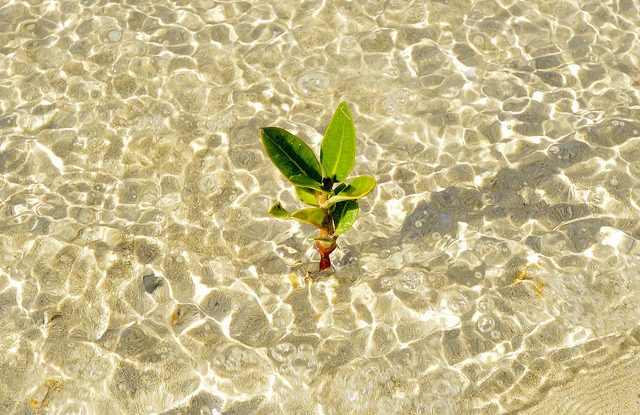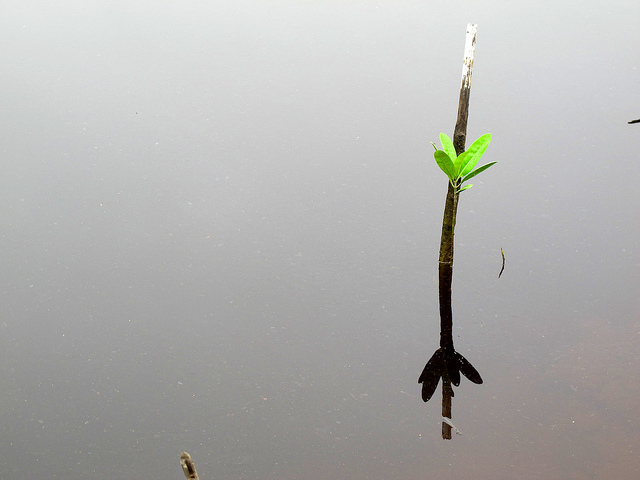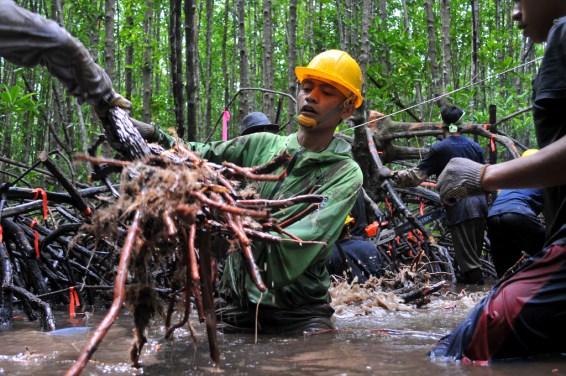
Delegates are gathering for the 22nd session of a climate conference in Marrakesh, Morocco, from 7-18 November. It is interesting to note that after so many years, oceans will be part of the United Nations Framework Convention on Climate Change (UNFCCC) Conference of the Parties (COP) agenda. Why oceans? Why now?
Do oceans and seas have anything to do with the global climate?
Coastal blue carbon is known as the carbon stored in tidal wetland ecosystems, which includes tidally-influenced forests, mangroves, tidal marshes and seagrass meadows. It is kept within soil, living biomass and non-living biomass carbon pools.
Coastal blue carbon is a subset of blue carbon that also includes ocean blue carbon, which represents carbon stored in open ocean carbon pools.
Coastal wetland ecosystems are the most effective carbon storehouse on earth. They are capable of capturing and storing excessive atmospheric carbon with burial rates 20 times larger than any terrestrial ecosystems, including boreal and tropical forests. However, coastal wetlands are among the most threatened natural ecosystems.
Greenhouse gas emissions due to unsustainable coastal development are up to one billion tons per annum- 20 percent of the emissions from global deforestation. Indonesia, where almost a quarter of the world’s mangroves reside, contributes one-fifth (200 million tons CO2-eq) of its national emissions- an amount equal to 40 million fewer cars on the roads.
The sediment-trapping capacity of coastal blue carbon when restored and protected properly would facilitate these ecosystems to play an important role as “land builders”, a kind of ecosystem service that had never been monetized, in the face of a one-meter sea level rise by the end of this century.
Oceans, along with marine and coastal resources, play an essential role in the well-being of people who live in coastal zones. Together, they represent 37 percent of the global population. Coastal and marine resources contribute an estimated $USD 28 trillion to the global economy each year through ecosystem services.
According to the Sustainable Development Goals (SDGs) Report, however, those resources are extremely vulnerable to environmental degradation, overfishing, climate change and pollution. Its 14th goal, SDG 14 “Life below water”, is to conserve and use the oceans, seas and marine resources for sustainable development.
One of the targets of SDG14 is that by 2020 marine and coastal ecosystems should be sustainably managed, protected and restored to achieve healthy and productive oceans. We are not nearly close enough to this target. In contrast, these ecosystems are disappearing rapidly.
A new global climate treaty, the Paris Agreement, was adopted in December 2015. Its central aim is to strengthen the global response to the threat of climate change by keeping a global temperature rise this century well below 2 degrees Celsius above pre-industrial levels and to pursue efforts to limit the temperature increase even further to 1.5 degrees Celsius.
The Paris Agreement requires all parties to put forward their best efforts through nationally determined contributions (NDCs) and to report regularly on their emissions and on their implementation efforts. Considering the potential of blue carbon to mitigate climate change, it is timely that blue carbon should be part of the national climate strategy.
In response to the new climate treaty, the International Partnership for Blue Carbon (IPBC) was established at the 2015 Global Landscapes Forum in Paris, France- the biggest side event at COP21. The momentum to work together to use the opportunities is ripe.
The partnership was created by the governments of Australia, Indonesia and Costa Rica, alongside the following founding partners: the Blue Carbon Initiative (Conservation International, IUCN, Intergovernmental Oceanographic Commission – UNESCO), GRID-Arendal, the Secretariat of the Pacific Regional Environment Program (SPREP), the Pacific Islands Forum Secretariat and Office of the Pacific Oceanscape Commissioner, the Global Change Institute and the Center for International Forestry Research (CIFOR).
Blue carbon has huge potential for climate change mitigation and adaption. Mechanisms such as Reducing Emissions from Deforestation and Forest Degradation (REDD+), Nationally Appropriate Mitigation Actions (NAMA) and Joint Mitigation and Adaptation (JMA) should be utilized to enhance the resilience of coastal ecosystems and communities to cope with the changing climate and rising sea levels.
As far as the agreement is concerned, the financial arrangement may be consulted with the Green Climate Fund (GCF) through the Nationally Designated Authority (NDA). A number of accredited entities have been approved by the GLF’s board to implement the programs and projects at various levels.
There are also a range of initiatives and like-minded groups, such as the Blue Carbon Initiative from Conservation International (CI), the International Union for the Conservation of Nature (IUCN) and UNESCO’s Intergovernmental Oceanographic Commission (IOC), as well as the United Nations Enviroment Program’s (UNEP) Blue Carbon Initiative, which are ready to lend their hands for capacity development purposes. They may be engaged in joint restoration and protection efforts.
Further steps need to be taken to improve the accountability of measurement, reporting and verification efforts in national communication and project development.
Blue carbon science is advancing to support policymakers with credible scientific information to make sound decisions relating to sustainable use of coastal and marine resources. Scientists from research organizations and universities are continuously improve their understanding, hence reducing uncertainties around the fate of blue carbon.
At the Marrakesh COP22, where oceans will for the first time be part of the agenda, delegates should strive to pave the way to meet common goals for humanity.
At the Marrakesh COP22, where oceans will for the first time be part of the agenda, delegates should strive to pave the way to meet common goals for humanity.
The suffering planet earth and vulnerable coastal communities cannot wait any longer for strong and ambitious decisions related to climate change mitigation and adaptation, of which blue carbon is an important component.
*This article was originally published in the Jakarta Post.
We want you to share Forests News content, which is licensed under Creative Commons Attribution-NonCommercial-ShareAlike 4.0 International (CC BY-NC-SA 4.0). This means you are free to redistribute our material for non-commercial purposes. All we ask is that you give Forests News appropriate credit and link to the original Forests News content, indicate if changes were made, and distribute your contributions under the same Creative Commons license. You must notify Forests News if you repost, reprint or reuse our materials by contacting forestsnews@cifor-icraf.org.

